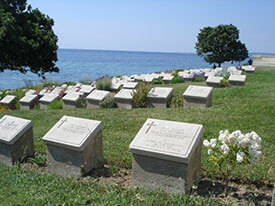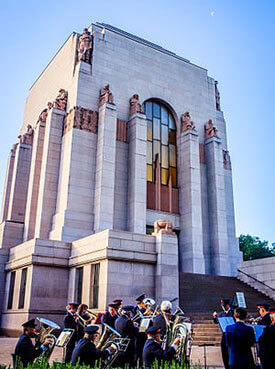Warfare, Sacrificial Death and Memorialization
Richard A. Koenigsberg |
||||
Waging war requires engaging in battle, where some citizens may become casualties. Citizens who die in battle (often soldiers) are said to have made the “supreme sacrifice.” Their sacrificial death is conceived as a gift: they have given their lives to their country—so that the nation might live. Subsequent to a war (or during it—as was the case in the First World War), a nation may create monuments—whose purpose is to preserve the memory of soldiers who have “given their lives” in the process of fighting for or defending the nation. Gravestones memorialize or symbolize the dead soldiers who have sacrificed their live. The purpose of the memorial is to honor the soldier: remember him for the sacrifice he has made. Gravestones honor human beings who made the supreme sacrifice. The implicit reward is the promise of immortality. By virtue of his sacrifice, the soldier will be “remembered forever more.” The case of Australia demonstrates the relationship between nationalism, death in war and memorialization or public remembrance. The Australian and New Zealand Army Corps (ANZACs) were part of a largely British force that landed at Gallipoli in April, 1915 to attack the Ottoman Empire (now Turkey), which was fighting on the German side. This began an eight-month campaign. The landing on the shores of Gallipoli was the first major military operation in which Australia, a newly federated nation, had been involved. Thousands of Australian were slaughtered. In spite of the fact that the campaign was an utter disaster, Australians instituted “Anzac Day” to remember and honor the courageous soldiers who had lost their lives in battle. Australia finally could become a real nation. It had something to point to—to show the world—proof of the “strength of the Australian national character.” “Anzac” came to symbolize the soldiers staying true to the “idea of Australian manhood.” By virtue of their courage at Gallipoli, the world discovered “the character of Australian men.” Anzac, it is said, “gave birth” to the Australian nation. The Australian nation, to put it bluntly, came into being—into its own—based on the slaughter of its young men. Memorials exist to recall or remember sacrificial death. They symbolize soldiers who have died (so their country might live). Commemorating the soldier suggests that he did not die in vain. The gravestone or cross or monument constitutes proof that that the nation for which he has given his life exists. Wars are fought in order produce sacrificial death and to generate war memorials. Thousands of memorials and monuments are scattered throughout Australia, and have been visited by millions of Australians. These memorials and monuments symbolize soldiers who have died for their country. They testify to the existence of the Australian nation. The following passage is from a eulogy delivered by Prime Minister P. J. Keating at the funeral service of the Unknown Australian Soldier on November 11, 1993:
The Tomb of the Unknown Soldier honors the memory of those who laid down their lives for Australia. It is a reminder of what was lost in war, and what was gained. What was lost was 100,000 lives—the hope and energy residing within these bodies that had ceased to exist. What was gained was a story of bravery and sacrifice that generated for citizens a “deeper faith”; an understanding of what it means to be Australian. One may hypothesize that the purpose of war is to generate death in order to create a certain kind of story or narrative. The purpose of this narrative is to give citizens “faith” in their country. The gravestone or tomb is a reminder or remembrance of soldiers who died—rekindling faith. The body and energy of the soldier is transformed into a tomb. A soft, vulnerable human being is transformed into a rock (“solid as a rock”). The memory of the soldier’s sacrificial act—symbolized by a gravestone—reminds us of those who gave their lives—so that our nation might live. Richard A. Koenigsberg, PhD: (718) 393-1081 |
 ANZAC graves at Gallipoli
ANZAC graves at Gallipoli The Shrine of Remembrance in Melbourne—a memorial to all Australians who have served in war
The Shrine of Remembrance in Melbourne—a memorial to all Australians who have served in war ANZAC Memorial, Hyde Park, Sydney
ANZAC Memorial, Hyde Park, Sydney